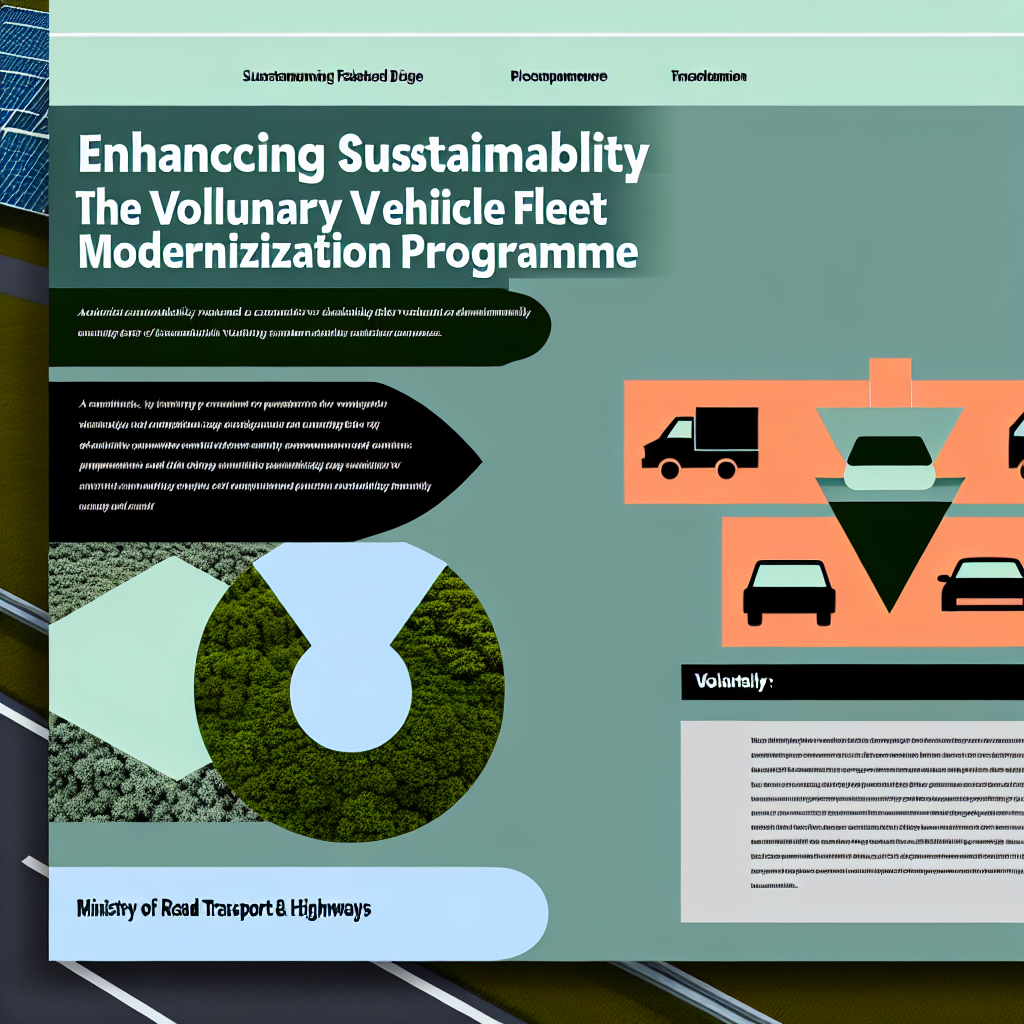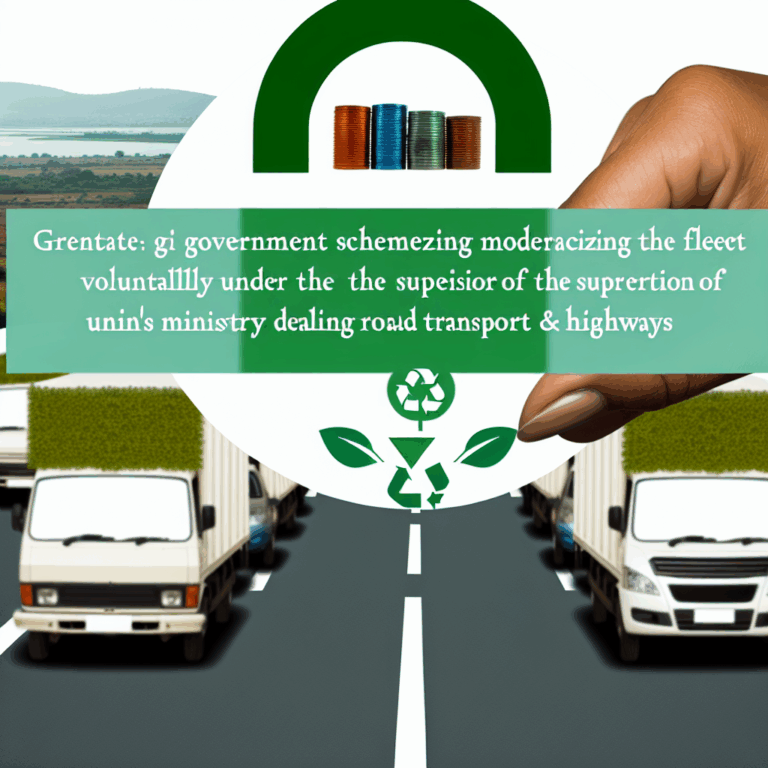Copyright @ 2023 www.digimitr.com. All rights reserved.

Enhancing Sustainability: A Comprehensive Guide to the Voluntary Vehicle Fleet Modernization Programme by the Ministry of Road Transport & Highways
Discover the key aspects of the government scheme titled “Enhancing Sustainability: A Comprehensive Guide to the Voluntary Vehicle Fleet Modernization Programme by the Ministry of Road Transport & Highways”. This program is overseen by the relevant ministry and focuses on providing benefits to eligible beneficiaries.
Here is a comprehensive overview:
Sustainability has become a cornerstone of modern policy-making, particularly in transportation, where emissions contribute significantly to climate change. In response to this challenge, the Ministry of Road Transport & Highways (MoRTH) in India has introduced the Voluntary Vehicle Fleet Modernization Programme (VVMP). This initiative aims to modernize vehicle fleets across the nation, enhancing environmental performance while fostering economic growth. The programme not only targets older, polluting vehicles but also promotes the use of cleaner technologies, thereby playing a pivotal role in India’s journey toward sustainability.
Eligibility Criteria
The VVMP is designed to be accessible, and its eligibility criteria reflect this intention. Vehicle owners, fleet operators, and state transport departments can participate in the programme. Specifically, it targets older vehicles that do not meet current emission norms, thereby prioritizing the replacement of these vehicles with newer, more efficient models. Additionally, any vehicle over a certain age, typically those older than 15 years, can be considered for modernization or scrappage under the initiative. Governments at the state and local levels can also partner in implementing the programme, thereby ensuring wider reach and impact.
Key Features and Benefits
The VVMP comes packed with multiple features designed to encourage vehicle owners to upgrade their fleets. One of the primary benefits is the financial incentive offered to kill older vehicles. Owners may receive scrappage certificates, allowing them to access discounts on new vehicle purchases. This not only incentivizes modernization but also effectively removes older vehicles from the roads, reducing emissions significantly.
Moreover, the programme emphasizes the adoption of electric and hybrid vehicles, aligning with India’s broader goal of promoting clean energy solutions. By facilitating easier access to upgraded vehicles, the VVMP also helps in improving fuel efficiency, leading to cost savings for consumers and reduced carbon footprints.
Application Process
The application process for the VVMP is straightforward. Interested participants can apply online through the MoRTH website or designated portals set up by regional transport authorities. The first step involves filling out an application form that captures vital information about the existing vehicle and the owner’s details. Following this, applicants need to provide necessary documentation, including registration certificates and proof of ownership.
Once the application is submitted, it undergoes a verification process. After approval, vehicle owners receive the scrappage certificate, which can then be utilized to avail benefits while purchasing new vehicles. The seamless nature of the application process aims to encourage more stakeholders to take part in the initiative.
Funding and Budget
Financial backing is crucial for the success of any programme, and the VVMP is no different. The government has allocated significant funds to support the initiative, with a focus on providing subsidies and incentives to participants. Funding comes from both central and state budgets, with specific allocations determined based on the projected benefits to the environment and the economy.
The subsidies aim to cover a part of the new vehicle cost, thereby making the transition economically feasible for owners of older vehicles. Moreover, the government collaborates with private financial institutions to facilitate loans and financing options for vehicle upgrades, allowing participants to manage their investments effectively.
Achievements or Impact
Since its inception, the VVMP has made notable strides in promoting sustainability in India’s transportation sector. By facilitating the scrapping of older vehicles, the programme has contributed to a substantial reduction in vehicular emissions, improving air quality in urban areas significantly. Reports indicate that thousands of vehicles have been scrapped under the initiative, leading to a marked shift toward modern, fuel-efficient alternatives.
The impact of the VVMP extends beyond environmental benefits; it has also stimulated economic activity. The automotive sector has witnessed growth due to increased demand for new vehicles, creating jobs and boosting manufacturing. Furthermore, as more electric and hybrid vehicles enter the market, public awareness and acceptance of cleaner technology are gradually rising.
Challenges
Despite its successes, the VVMP has faced several challenges. One of the primary hurdles is the public’s resistance to change. Many vehicle owners are hesitant to part with their older vehicles due to emotional attachment or the perceived financial burden of purchasing new ones. Additionally, there are concerns regarding the availability and affordability of electric vehicles, which may slow down the transition process.
Implementation inconsistencies across different states can also pose challenges, as some regions may have more resources or better infrastructure to support the programme than others. Addressing these disparities is essential for ensuring that the initiative achieves its intended goals uniformly across the nation.
Recent Updates
The VVMP continues to evolve, with recent updates aimed at maintaining its relevance and effectiveness. The government is actively considering higher incentives, especially for electric vehicle adoption, reflecting a growing commitment to clean energy. Newly introduced pilot projects are also underway in various states to assess the effectiveness of different scrappage policy models, with findings aimed at refining the programme further.
Moreover, there’s an ongoing effort to improve outreach and education regarding the benefits of the VVMP. Public awareness campaigns are being launched to inform vehicle owners about the advantages of modernization, thus fostering greater participation. These updates indicate a proactive approach from the government to enhance the programme’s success and reach.
Conclusion
The Voluntary Vehicle Fleet Modernization Programme represents a significant step toward enhancing sustainability in India’s transportation sector. By focusing on modernizing fleets, incentivizing the scrappage of older vehicles, and promoting cleaner technologies, the initiative plays a vital role in reducing emissions and boosting economic activity. While challenges persist, the government’s commitment to refining and promoting the programme suggests a bright future for sustainable transportation in India. As more vehicle owners recognize the value of modernization, the environmental and societal benefits will inevitably multiply.
FAQ
1. Who can apply for the Voluntary Vehicle Fleet Modernization Programme?
Any vehicle owner, fleet operator, or state transport department with vehicles that do not meet current emission norms can apply. Typically, vehicles older than 15 years are eligible for scrapping under this initiative.
2. What incentives are available for participants?
Participants can receive scrappage certificates, allowing them discounts on new vehicle purchases. Additionally, there are financial subsidies aimed at making the upgrade process more affordable.
3. How is the VVMP funded?
The VVMP is funded through allocations from both the central and state government budgets, with additional support from private financial institutions. This funding primarily covers subsidies and incentives for vehicle modernization.
For more information, check out official government site,
Official government website or relevant source not provided.
Stay updated on related schemes and initiatives using hashtags: #Enhancing #Sustainability #Comprehensive #Guide #Voluntary #Vehicle #Fleet #Modernization #Programme #Ministry #Road #Transport #Highways
Share your thoughts about this scheme in the comments below!





